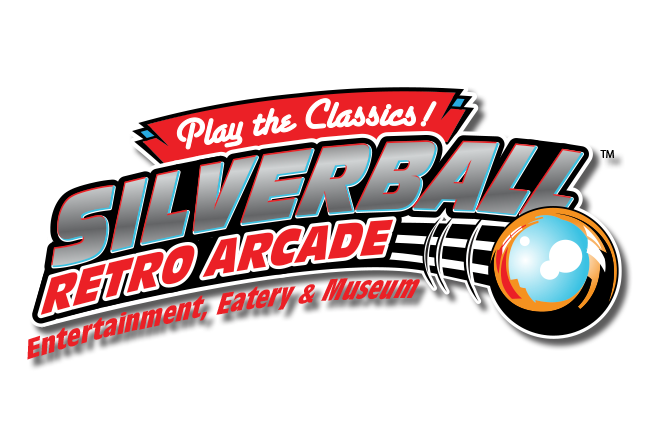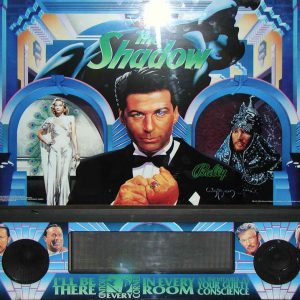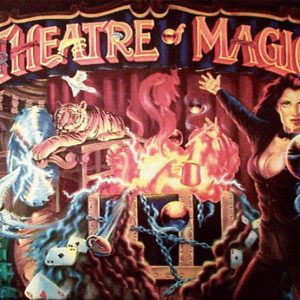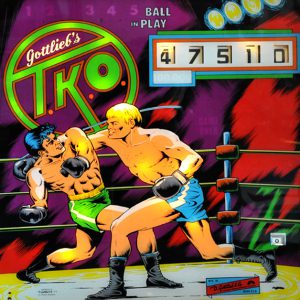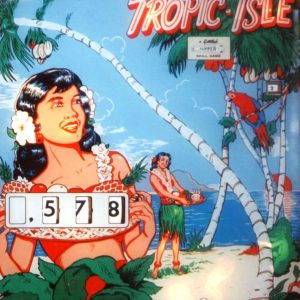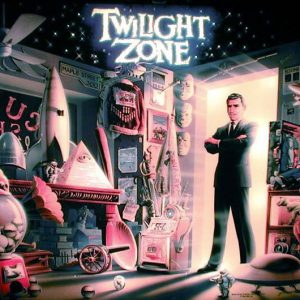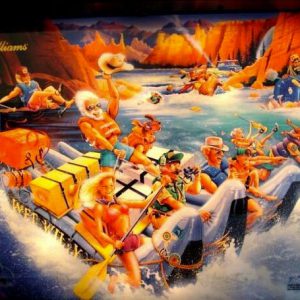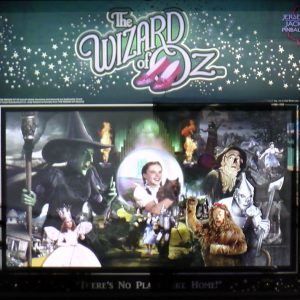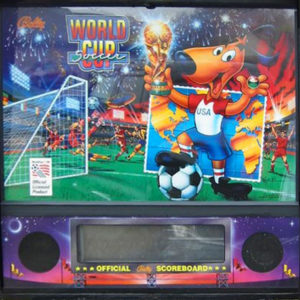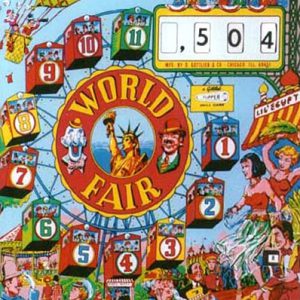-
This machine is based on the ’30s radio series then turned into a movie. Design accolades go to Brian Eddy with art scripted by Doug Watson. 4,247 of these machines were made. The interesting feature in this machine is the elevated upper-left playfield. This playfield is gained access to once the drop target is hit. Once this challenge is complete, another shot to this ramp shoots the ball upstairs to this feature. Pressing the flipper buttons moves the paddle left or right. The kicker is activated by an optic sensor automatically to hit all the targets if your aim is sure. This game also has a thrust magnet which grabs the ball in action and shoots it up the playfield into the next feature. No pop bumpers are on the playfield, which is a rare event. Another first incorporated into this playfield are two ramp diverters which are player adjustable. Completing the six scenes of the story award you with the final battle sequence of good against evil.John Popodiuk designed this magical game with artwork penned by Linda Deal. 6,600 units were manufactured. This game is always in the top 10 machines in collectibility. The magic trunk is the centerpiece of the playfield. Its multifunctional sides rotate according to the storyline of the machine at the time. Eight illusions are to be collected in a typical game. This is one of four requirements needed to complete the grand finale stage of the game. Advancing the clock to midnight by shooting the right-side lane 12 times or hitting the captive ball completes this feature. Multiball must be made at the trunk to complete the third part of the puzzle. The last issue is completing the word “theater” by certain ramp shots. Grand finale is tough to achieve but a neat show awaits you. Vanish is another feature that makes a ball disappear when shot up the left-side ramp; the ball reappears when the right ramp is made.Look no further! If you’re searching for the rarest of the rare, here for your perusal is not one but two examples of this Gottlieb aberration. Supposedly only 125 were made of this game and most were sold overseas. Ed Krynski and Gordon Morison again teamed up to art and design the game. This game represents one of the last electromechanical “wedgehead” games ever built near the shores of Lake Michigan. It’s also a single-player game and one of the last. The object of the game is not really boxing in the true sense but hitting enough targets to advance the central advance display up to the top of the rack. This will ignite the special lights for a free game. The color-coordinated advance inserts on the play field correspond to the light-up features on the play field and, if you advance the light sequence accordingly, those features light up for the brief time the advance mechanism stays on that light. Score is the easiest way to win a replay.Here’s another classic single-player wedgehead. This machine was designed by Jeff Brenner with art scrolled by Gordon Morison. 3,100 units came to fruition as well as an add-a-ball called Royal Pair. This open playfield design allows for a lot of action mandated by flipper shots all the way up the playfield. The object of the game is simple…by completing all the card targets and rollovers, three specials light. Hitting the ace target up top or scoring a lit rollover awards a replay. Another unique feature built into this machine is the random rollover values one may capture. 10, 100 or 1,000 points may be scored by rolling over one of four rollover targets when lit. The shots to the targets must be precise to score from the flipper. The outlanes are unique in design as they are angled. A very interesting variation of a Gottlieb card theme machine.Wayne Neyens designed this classic with Roy Parker penning the artwork. 2,700 of these were fabricated. This game has a holdover feature, which holds the monkeys’ positioning on the backglass from game to game. If you’re skillful enough to hit the A, B, C, and D targets, a monkey is advanced up the tree on the backglass. If one monkey makes it to the top, one replay is awarded: two monkeys score two replays, and three monkeys score three replays. Obviously if you pass this game and notice the third monkey nearing the top, feeding the coin slot was a natural for your just reward. Rolling over the 1 – 5 rollovers at the top of the playfield lights the side specials and awards 200 points once you drain the ball. A nice, well balanced game and quite a challenge not to lose your ball in play.This game is the most complicated solid-state pinball machine for complexity and gadgetry ever made. 15,235 of these were made and design credits go to Pat Lawlor with art by John Youssi. Multiple multi-ball options, magnets, a porcelain power ball a gumball machine and an extra-wide play field are only part of what’s before you. The main object of the game is to complete all the segments of the door in the bottom of the play field. These segments illuminate a light in the door. If by rare chance you complete the feat (you can “buy in” extra balls at the end of your game), all heck breaks loose in the form of a “lost in the zone” ultimate stage in the game. All six balls pop out, every option special, and bonus is lit all at once, and then, as if by magic, the flippers stop working (as this is a timed event) and your bonus is totaled. The battle in the zone magnet-controlled play field and power ball are neat!This one or two player upright video game is not just one dedicated game like Pac-Man or Missle Command. Through the use of modules or packs installed in the machine, more games could be added to its itinerary of playable classics. Early video games had full circuit boards within the machine as well as dedicated transformers and controls. Nowadays, emulators have taken over the arcade and home markets, allowing thousands of games in the footprint of one machine. Pinball machines have also been emulated in this formats. These games are finding themselves more and more in the home market for obvious reasons: you can have 100 of your favorite machines to come home to in one solo unit–and you own the keys!This machine was produced in january and 7300 copies of it were bolted together. Pat lawlor designed the game with john youssi penning the artwork. The earliest machines in the production run had the chicago cubs logo on the child’s baseball cap but the cubs disallowed its use so the logo was changed. The early examples had a williams logo sticker over the cubs logo. The object of the game is to advance the compass to the north, south , east and west positions. Doing so starts ball lock ..And the “power of the wind” through the use of a dedicated fan on top of the machine to recreate a new physical dimension to your gameplay. Once three balls are locked, the left ramp awards increasing million awards. By earning enough tolls, extra balls may be had. The super cellar value changes via the spinner. Dropping into the cellar awards its value. Another “twist“ in the game’s design is the spinning discs. Tornado action.White Water is a 1993 pinball game designed by Dennis Nordman and released by Williams. The theme is based on White water rafting, which is reflected in the game’s ‘wild’ ramps and very fast gameplay. Overview White Water is a non-licensed pinball machine with a primary objective of moving your raft down the river to “Wet Willy’s” in order to get the “Vacation Jackpot.” You move your raft down the river by shooting the flashing “Hazard” shots, each with a unique rafting theme name. Each time you complete a raft, the number of “Hazard” shots you must hit successfully to complete the next raft increases. It takes eight completed rafts to advance to “Wet Willy’s.” Successfully completing “Wet Willy’s” enables the player to attempt the collection of the “Vacation Jackpot.” There are subsequent objectives in the game, which include: Multiball: To start multiball, light the lock ball shot by hitting the “Lite” and “Lock” targets and then successfully shooting the ball in the ball lock, also called the “No Way Out” Hazard; doing this 3 times will start multiball. Whirlpool: Completing the “Whirlpool” shot will activate one of six awards or modes, which is determined by what is lit when the “Whirlpool” shot is hit. To light the “Whirlpool”, thus making the shot active, successfully hit the “Insanity Falls” shot. After hitting the “Insanity Falls” shot, you will know the “Whirlpool” is active when the red light above the shot is lit. One of the six awards or modes starts when the Whirlpool shot, also called “Bigfoot Bluff”, is successfully competed. Big Foot Hotfoot: There are two “Hotfoot” targets in the middle of the playfield. Hitting both targets comprises a complete “Hotfoot”, and the “Hotfoot” targets are reset. Depending on the machine settings, successfully completing the specified number of “Hotfoot” targets starts the “Bigfoot Hotfoot” mode which allows the player to get successive “Bigfoot Jackpots.” Lost Mine: Hitting the ball in the “Lost Mine” shot awards an item needed to start the “Gold Rush” multiball. There are three items that must be collected to start this multiball, a flashlight, a map, and a key; and these items can be collected through either the “Lost Mine” or the “Bigfoot Hotfoot.” Once all three items have been collected, successfully hitting the “Lost Mine” shot starts the “Gold Rush” multiball.Wow! What a light show! The machine before you represents the first offering from the fledgling company of Jersey Jack Pinball of Lakewood, N.J. A pinball of any production hasn’t been made in the state for decades. This machine was created as a centerpiece of technology to show the arcade world what a contemporary machine can contain in one package. Stern, the only other U.S. maker of pinball, has always streamlined the process of pinball manufacturing and kept the number of pinball “toys” on a machine to a minimum to make their machines less expensive. Since this machine came out, Stern now offers three models of their newer machines: a stripped basic unit, an average machine contents wise and a tricked-out collectable unit to compete with the likes of Jersey Jack. Look at this machine! Mike Balcer designed the playfield; Jerry Vandersteldt, Greg Freres and Matt Riesterer penned the artwork. 1,000 units are already spoken for and both a special edition (the one here) and a standard edition are planned. Five flippers, five magnets, color changing LEDs, a 26-inch LED monitor, shaker motor, ball lift, spinning house toy, crystal ball projector, rising witch and wide-body package are only some of the innovations seen here.This classic game is currently rated as the number two game of its generation. 4,650 units were produced in April of the year with design credits going to Roy Parker for artwork and Wayne Neyens for design. The game was produced to coincide with the New York World’s Fair of 1964-1965. The 11 ferris wheel cars depicted on the backglass are represented on the play field by roll overs and targets. Hitting a numbered car lights the corresponding backglass car. The interesting gadget developed for this game is the center spinning disc (i.e. ferris wheel) in the middle of the game. By spinning the disc, one randomly spots a ferris wheel car on the backglass. Completing all the cars awards a replay and the randomly advancing lighting of a rollover which, if you’re skilled enough, would award a replay if hit. Score is another way to conquer the machine. Enjoy trying your hand at this classic machine.
-
This machine is based on the ’30s radio series then turned into a movie. Design accolades go to Brian Eddy with art scripted by Doug Watson. 4,247 of these machines were made. The interesting feature in this machine is the elevated upper-left playfield. This playfield is gained access to once the drop target is hit. Once this challenge is complete, another shot to this ramp shoots the ball upstairs to this feature. Pressing the flipper buttons moves the paddle left or right. The kicker is activated by an optic sensor automatically to hit all the targets if your aim is sure. This game also has a thrust magnet which grabs the ball in action and shoots it up the playfield into the next feature. No pop bumpers are on the playfield, which is a rare event. Another first incorporated into this playfield are two ramp diverters which are player adjustable. Completing the six scenes of the story award you with the final battle sequence of good against evil.

